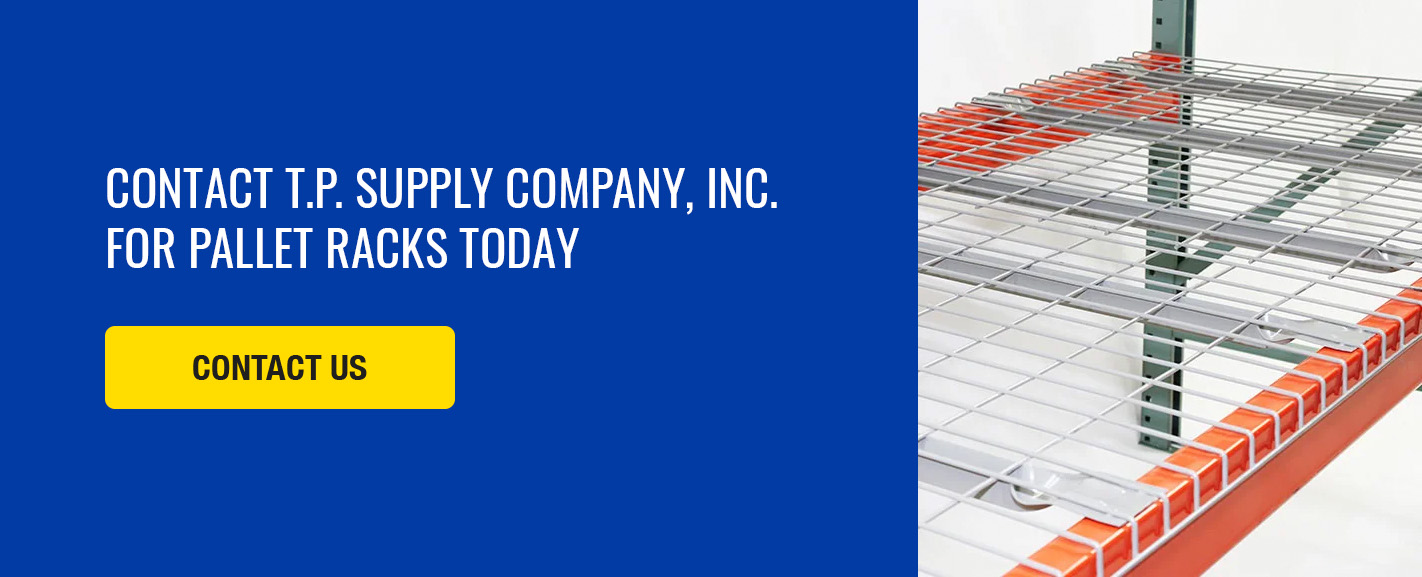Guide to Pallet Rack Assembly and Installation
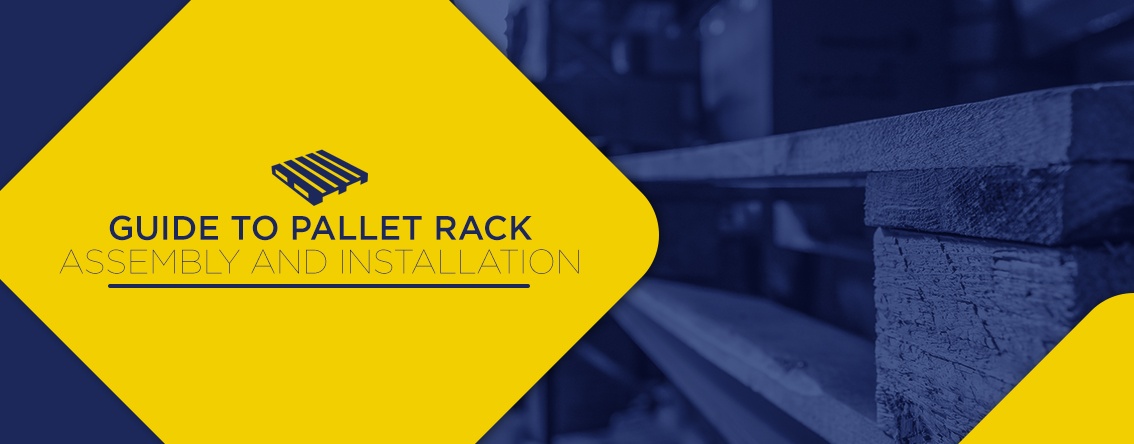
Pallet Rack Assembly Guide
Warehouse operators rely on secure pallet racking systems for efficient storage and organization. With a proper racking system, you can optimize your warehouse, maximizing storage space and making your inventory more accessible.
As crucial as they are, these benefits are only possible with proper pallet-racking installation. With the correct assembly, pallet racking systems work as designed. Most importantly, proper pallet racking installation ensures a system that keeps your warehouse safer and more compliant with industry standards.
This guide to pallet racking assembly systems explores various aspects, including the importance of consulting professional instructions, project planning and installation techniques.
View Our Pallet Racking Solutions
How Do You Assemble a Pallet Rack?
Installing and assembling pallet racks is fairly straightforward. As long as you remember to keep checking that all beams and uprights are level and even with one another, your project will be complete in no time. Segmenting the various steps for proper installation also helps simplify the process:
1. Put Safety Considerations First
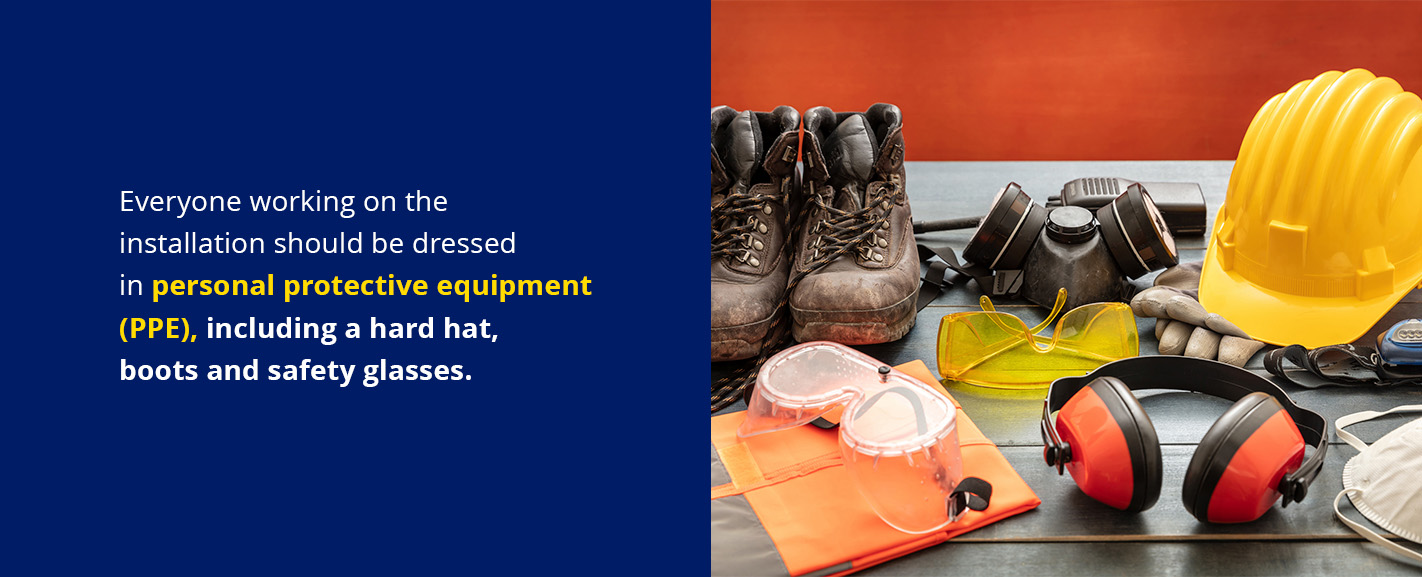
Before getting started on your installation, it is essential to ensure that anyone who will work on the pallet rack assembly has a core understanding of warehouse safety procedures. This includes various important aspects:
- PPE: Everyone working on the installation should be dressed in personal protective equipment (PPE), including a hard hat, boots and safety glasses. It is also beneficial to have a person who is trained in warehouse safety procedures on-site during the installation.
- Building and fire codes: To be compliant with local warehouse building codes and Occupational Safety and Health Administration (OSHA) fire safety standards, ensure that your installation has the correct aisle widths and exit layout in case of emergency. You should also have the correct signage to highlight emergency exits and fire extinguishers.
2. Consult the Installation Guide
Before you begin installing and assembling your pallet racks, consult the user manual or installation guide that came packaged with the product. Inside, you should find specific instructions, guidelines and requirements for the type of pallet rack you’re installing. This is important, as a teardrop pallet rack assembly can be vastly different from a double-slotted pallet rack, for example. Read through the materials and compile a list of the supplies you need to complete the project, including:
- All uprights and beams
- Shelves or decking
- A tape measure
- A chalk line
- A level
- A lifting device
- A mallet
- At least one assistant
The manufacturer’s guide to pallet racking systems should also contain the following key information:
- Clearance requirements for ceilings and walls and width requirements and dimensions for forklifts
- Design information like seismic design requirements
- Average and maximum load weights
- Load size
- Required accessories
- And pallet type and size
If your pallet racks did not come with a manual, contact the manufacturing company for specific instructions or answers to any questions.
3. Inspect the Pallet Rack Components
The next step is to verify that all components and accessories for pallet racks are included and to check all parts for damage or defects. You can include the following in your checks:
- Uprights and columns: Check the uprights and beams for rust and corrosion, deflection, bowing, sagging and cracks and bulges.
- Struts: The bracing between columns, called struts, should be free of rust and corrosion.
- Row spacers: For systems that need row spacers, none should be missing, and all should be free of any noticeable defects.
- Beams: Beams essentially make up the racking’s shelving and will support pallet loads. Since they provide structural support, it is important to check that there are no deflections, cracks, dents or bulges. All beam connectors and support accessories, including safety pins, should be in good condition.
4. Prepare the Workspace
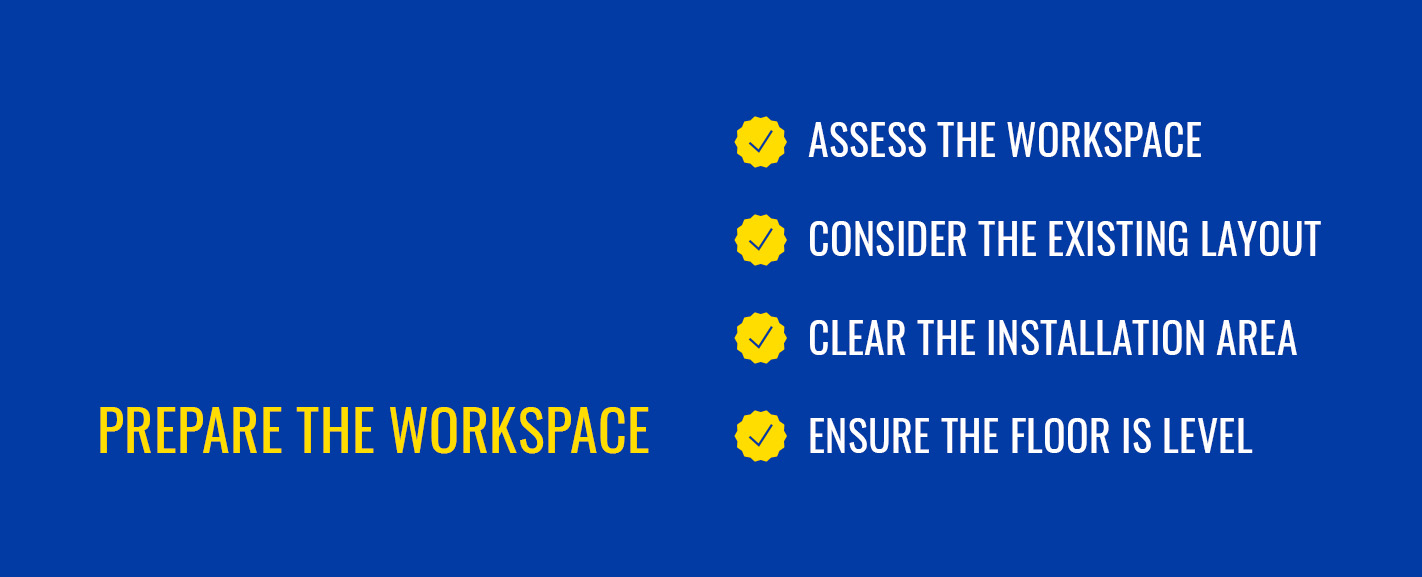
Once you have inspected all the system’s components, it’s time to assess the space you will use and the layout:
- Assess the workspace: Before installing the racking system, measuring the space is vital. Note the dimensions of your pallet racking and measure those lines on the floor. To simplify the bay installation, mark the length and width with a chalk line and the location for the uprights.
- Consider the existing layout: Be sure to leave plenty of room between the edge of the pallet racking and the wall, as well as ample space between aisles for workers and pallet lifts to move safely. Also note any obstructions in the area like overhead beams, electrical panels, pipes or pillars.
- Clear the installation area: The area should be clean and free of any unnecessary clutter.
- Ensure the floor is level: A floor’s condition is vital to a structurally sound pallet racking system. The floor needs to be plump, meaning level. An uneven floor will compromise its stability and, thus, safety. You can install shim plates underneath baseplates to level the rack if the floor is uneven.
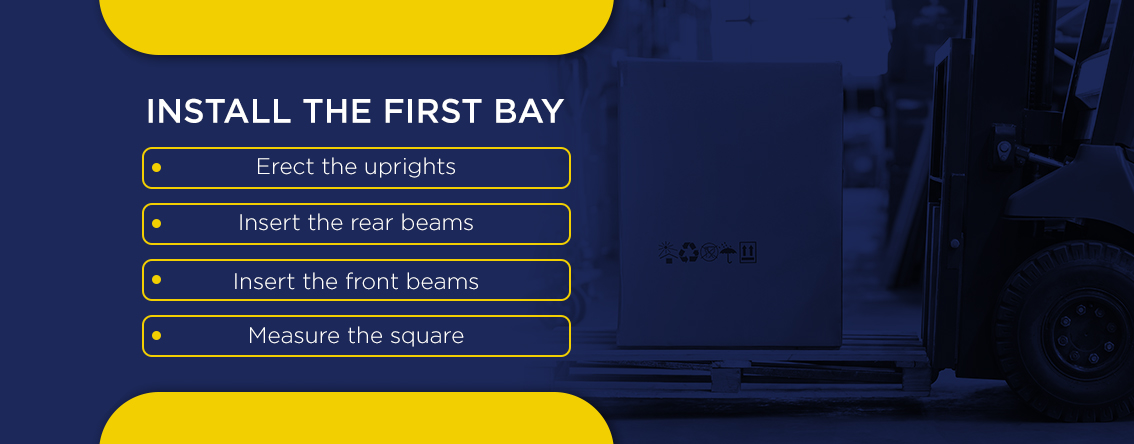
5. Install the First Bay
If you don’t know how to install pallet racking, the easiest and most effective way to approach the project is one bay at a time. Take the time to get your first bay just right — with equal, precise measurements and secure attachments — before you move on to subsequent bays.
Gather your tools and work with an assistant to follow these steps:
- Erect the uprights: Using the chalk line as your guide, stand one upright on the outer edge and hold it in place. With the help of an assistant, erect the second across from the first. Use a level to check that the uprights are vertical. If they aren’t, place shims underneath the uprights until they are straight. Typically, a slight tilt of no more than 1/8 inch is okay, but check the installation guide for specific instructions from your manufacturer. Anchor the uprights to the floor using the recommended method in your installation guide.
- Insert the rear beams: Insert the bottom rear beam first. With the help of your assistant, place the bottom rear beam in the correct slots between the two uprights, and use a mallet to secure it in place gently. If your beams do not use a slotting system, you may need to bolt them to the frame. Repeat this process with the top rear beam. Depending on the height of your uprights and racking system, you might need to use a lifting device to attach the beams and uprights.
- Insert the front beams: Once you have installed and secured the two rear beams, it’s time to install the front beams. Start with the top front beam, placing it at the exact level as the top beam at the rear. Secure it like you did the rear beam, then move on to the fourth and final beam installation. Once you have installed all four beams, you have formed your first bay.
- Measure the square: Use a tape measure to check that the first bay measures as a square and that all spacing is correct and equal. This is an important step, as it will save you a headache later on when installing your shelving. Once you are done with the beam installation and deck installation or shelving, you can repeat the process for additional bays.
6. Finish Remaining Bays
Depending on the desired length of your racking system, you will likely need to create several more bays before laying shelves or decking to finish the project. To assemble the remaining bays, repeat the process you used for the first one. Start at the first bay and use a chalk line to check that all uprights are straight and even with one another and that all beams are at matching heights.
7. Add Shelves or Decking
Once you have installed your uprights and beams and ensured that all bays are squared, it’s time to add shelving or wire decking. Choose the best type of shelf or deck for your industry, keeping in mind the anticipated weight of your stored products. For example, wire mesh deck shelving is ideal for food service, retail, manufacturing and warehouse environments because it is strong, versatile and easy to use.
Benefits of Using a Professional Installer
If you don’t know how to assemble industrial shelving, consider opting for a professional installation of pallet racking systems. There are several reasons why this might be a good option for you. You may not have the time, supplies, or available assistance needed to take on pallet rack assembly by yourself. Or, your pallet rack design might be intricate or large-scale and require a professional eye to ensure proper installation.
Some benefits of using a professional pallet rack installer include:
- The spare time and energy you need to focus on the daily operations of your business.
- A knowledgeable and experienced work crew who works quickly to get your pallet racking set up.
- A stress-free installation process that complies with OSHA warehouse standards.
The experts at T.P. Supply have taken on various industrial racking projects, including structural racks, conveyor systems, pick modules, cantilever racks and more. Because we offer complete package services, we can also help with the takedown and relocation of your supplies.
FAQ
The answers to these frequently asked questions can help simplify assembly and installation of pallet racks:
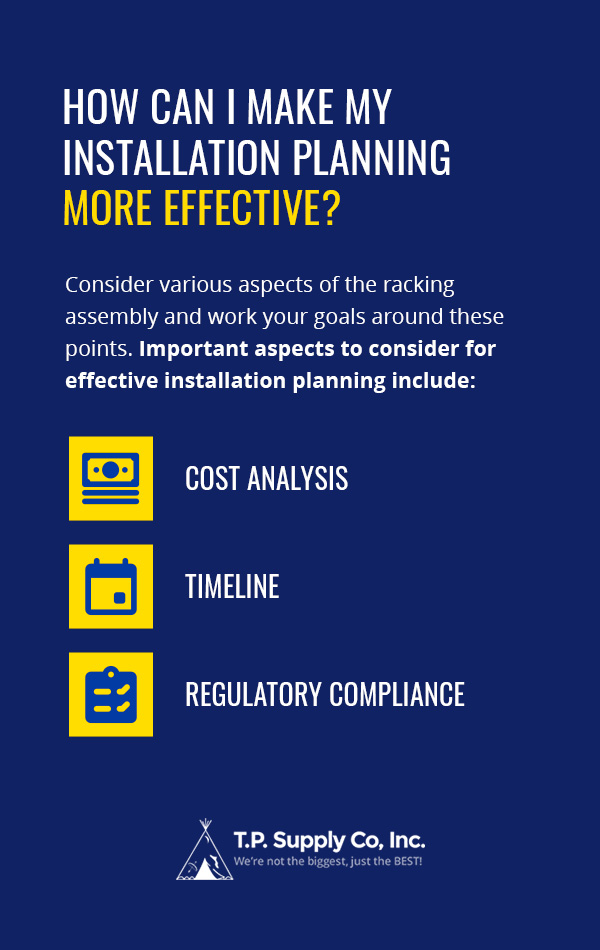
How Can I Make My Installation Planning More Effective?
Planning for installing racking systems is as important as the installation itself. To make your planning as effective as possible, consider various aspects of the racking assembly and work your goals around these points. Important aspects to consider for effective installation planning include:
- Cost analysis: As part of your cost analysis, consider your warehousing needs to determine if you can opt for single-deep pallet racks, which are the most cost-effective pallet racks, or if you can budget for a more advanced racking system. You can also look into other options like purchasing used or reconditioned pallet racking systems.
- Timeline: Another important consideration is how time-sensitive your project is. If you need your installation completed ASAP, consider working with an expert team that can install your rack professionally and within a tighter deadline.
- Regulatory compliance: Whether you are installing new pallet racks or upgrading an existing system, keeping your warehouse compliant with industry standards is essential. Definitely factor in having a warehouse racking inspection done after completing your intallation.
What Is the Average Time It Takes to Install Pallet Racking?
The time it takes to install your racking system will depend on several factors, including the scope of the project and the size of your team. On average, a small system can take a couple of hours to install while a large system can take several weeks to install. Another consideration is that if you work with a professional pallet rack installer or team, you can expect the timeframe for the installation to be much quicker.
How Can I Customize My Pallet Rack Installation?
It makes sense that depending on your industry or the clients you service, you will have your unique requirements for your pallet rack and how you need to assemble it. Thankfully, there are various ways you can customize your racking systems:
- Choose your pallet racking system: There are different types of pallet racking systems that you can install. There are selective pallet racks, which are very popular since they are versatile and suit various items. If you have high-density storage needs and a first-in-first-out (FIFO) system, then drive-in and drive-out racks are ideal. You may also opt for pallet flow racks, which optimize efficiency and work well if you store perishable goods.
- Accessorize: The most effective way to customize your new rack is by choosing quality pallet racking accessories that complete the installation. This can include products like wire mesh decking, column protectors and row spacers, as well as essential safety and security features like rack guards.
Contact T.P. Supply Company, Inc. for Pallet Racks Today
If you need professional, reliable pallet racking solutions and services, look no further than T.P. Supply Company, Inc. We supply quality industrial pallet rack systems and components, including wire partitions, guard rails, aisle protection, bollards and more. We also have a professional in-house team that provides you with convenient, reliable delivery and installation services.
With T.P. Supply Company, Inc., you get the full package, from customized quotes to professional advice you can trust. Contact us today for your pallet racking installations or with any questions!


